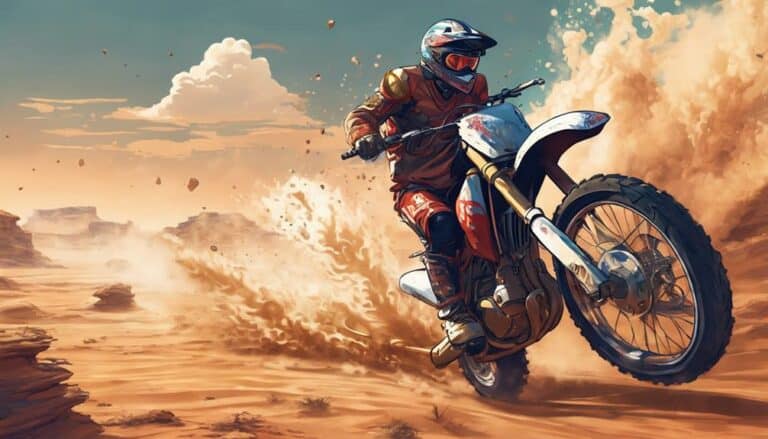When traversing the terrain on your water-cooled dirt bike, think of your speed as a delicate balance, much like walking a tightrope. Finding the sweet spot to prevent overheating is a skill that requires precision and knowledge of your bike's capabilities.
But how fast must you go to keep the engine cool without pushing it too far? Let's uncover the secrets to maintaining the perfect speed for ideal cooling efficiency and engine performance.
Key Takeaways
- Riding consistently at speeds between 30-40 mph optimizes water cooled dirt bike cooling efficiency.
- Avoid high speeds over 50 mph to prevent overheating and maintain proper engine temperature.
- Monitor environmental factors affecting cooling system effectiveness while riding.
- Upgrading radiator components can enhance cooling system performance and prevent overheating.
Optimal Speed for Cooling System Efficiency
What's the ideal speed range for maintaining efficient cooling in a water-cooled dirt bike?
When it comes to the cooling system of your dirt bike, hitting speeds below 50 mph is key to preventing overheating. The perfect range typically falls between 30-40 mph, ensuring that the cooling system can effectively circulate coolant and dissipate heat. Riding at consistent speeds within this range allows for the proper functioning of the cooling system, keeping your engine at an ideal temperature.
Venturing into higher speeds above 60 mph can pose a risk of increased heat generation, demanding a balance between airflow and coolant circulation to maintain cooling efficiency. It's essential to find that sweet spot where the cooling system can work optimally without being overwhelmed by the engine workload. Riding in lower gears at slower speeds aids in this process, enabling the cooling system to function efficiently and prevent overheating.
Factors Affecting Dirt Bike Temperature
Higher speeds on a water-cooled dirt bike can impact various factors that influence the engine temperature, including airflow through the radiator and the workload on the cooling system. When considering the temperature rise and cooling efficiency of your dirt bike, it's important to understand the following:
- Airflow: Riding at higher speeds increases the airflow through the radiator, promoting better heat dissipation and aiding in maintaining best engine temperature.
- Engine Parts: Consistent speed without frequent stops allows the cooling system to function efficiently, preventing excessive strain on engine components and potential overheating.
- Terrain Challenges: Uphill riding or demanding terrains may necessitate slower speeds to avoid overworking the engine and risking overheating issues.
- Environmental Factors: Ambient temperature, humidity levels, and altitude can influence the cooling system's effectiveness, affecting the speed required to prevent overheating and guarantee engine health.
Understanding Water Cooled Dirt Bike Mechanics
Utilizing a water jacket system filled with a coolant mixture, water-cooled dirt bikes effectively regulate engine temperature by absorbing heat from the cylinders and directing it to the radiator for dissipation. The cooling system of a water-cooled dirt bike comprises various components such as radiators, hoses, pumps, and fluid circulation mechanisms, all working together to maintain best engine temperature. The coolant circulates through the water jacket, absorbing heat generated during combustion before transferring it to the radiator.
The radiator then dissipates this heat into the surrounding air, preventing the engine from overheating. Upgrading certain parts like radiator caps and using silicone hoses can improve the overall efficiency of the cooling system, enhancing the bike's performance during demanding rides. Regular maintenance, including cleaning the radiator and checking fluid levels, is essential to make sure the proper functioning of the cooling system and prevent issues related to engine temperature.
Understanding the mechanics of a water-cooled dirt bike's cooling system is essential for maximizing performance and longevity.
Maintaining Engine Temperature While Riding
To maintain prime engine temperature while riding a water-cooled dirt bike, it's essential to guarantee consistent airflow and avoid prolonged idling or slow-speed riding. Ensuring the right riding speed is critical in managing engine temperature effectively.
Here are some key tips to help you maintain the best engine temperature while riding your water-cooled dirt bike:
- Riding Speed: Maintain moderate speeds around 30-40 mph to aid in cooling the engine efficiently.
- Airflow: Guarantee consistent airflow by riding at speeds above 20 mph, which is essential for effective engine cooling.
- Avoid Idling: Prevent overheating by avoiding prolonged idling or slow-speed riding, as these can lead to heat buildup.
- Gear Selection: Opt for higher gears at lower RPMs to reduce heat generation and manage engine temperature effectively.
Remember to keep an eye on the temperature gauge and adjust your riding speed accordingly to prevent overheating issues while out on the trails.
Tips to Prevent Overheating on Trails
On trails, maintaining a consistent speed is important in preventing overheating on water-cooled dirt bikes. Riding at a moderate pace helps dissipate heat away from the engine and radiator, reducing the risk of overheating.
Avoid prolonged high-speed riding, as it can strain the cooling system and lead to overheating issues. Additionally, excessive revving should be avoided to keep the engine temperature within a comfortable range.
Taking breaks during trail riding not only allows you to rest but also gives the bike a chance to cool down, preventing overheating. Proper jetting and throttle control are vital in managing heat buildup on the trails.
Make sure that the rubber hoses are in good condition and free from leaks to maintain efficient cooling system operation. By following these tips and being mindful of your riding habits, you can enjoy a smooth trail riding experience without the worry of overheating your water-cooled dirt bike.
Conclusion
Ride your water-cooled dirt bike like a skilled conductor, orchestrating a symphony of speed and temperature control. Find that sweet spot where the breeze kisses your face and the engine hums contentedly.
Avoid the siren call of reckless speed, instead, dance with precision and grace. By mastering the art of riding at the perfect speed, you guarantee a harmonious performance from your cooling system, keeping your engine happy and healthy for many rides to come.

